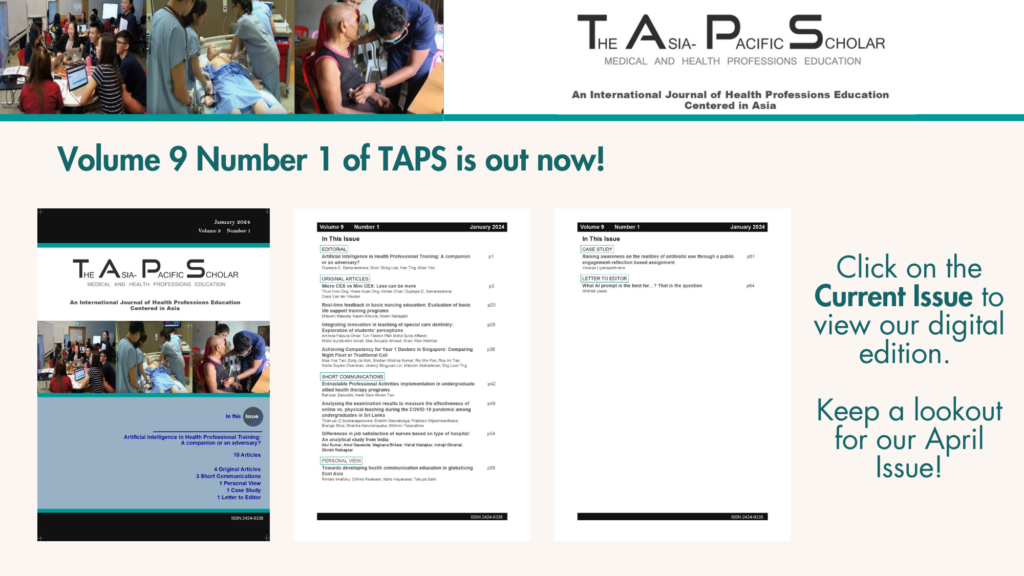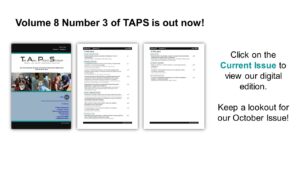Challenges in conducting virtual follow-up to chronic illness patients during the COVID-19 pandemic
Submitted: 6 May 2024
Accepted: 23 September 2024
Published online: 7 January, TAPS 2025, 10(1), 59-61
Kye Mon Min Swe1, Amit Bhardwaj2 & Hnin Pwint Phyu3
1School of Medicine, Newcastle University Medicine Malaysia, Malaysia; 2Department of Orthopaedics, Sengkang General Hospital, Singapore; 3M Kandiah Faculty of Medical and Health Science, University Tunku Abdul Rahman, Malaysia
I. INTRODUCTION
Telemedicine is defined as delivering healthcare services across distances using telecommunication technology (Waseh & Dicker, 2019). It helps ensure continuity of care for vulnerable patients to address the unique demands on our health system, especially in times of crisis, such as the COVID-19 pandemic, via virtual follow-up. It is also helpful in engaging medical students in training and patient care (Aron et al., 2020).
During the pandemic, virtual follow-up (VF) home visits were introduced in the integrated family medicine curriculum for Year 4 students. The family medicine curriculum for Year 4 students highlights the significance of comprehending chronic illnesses within the broader framework of the patient’s family and environment via the Follow-up Study of Patients with Chronic Illnesses programme, traditionally conducted through in-person patient visits. This study investigated the challenges faced while conducting virtual follow-up (VF) patient visits amidst the COVID-19 pandemic.
Announcements
- Best Reviewer Awards 2024
TAPS would like to express gratitude and thanks to an extraordinary group of reviewers who are awarded the Best Reviewer Awards for 2024.
Refer here for the list of recipients. - Most Accessed Article 2024
The Most Accessed Article of 2024 goes to Persons with Disabilities (PWD) as patient educators: Effects on medical student attitudes.
Congratulations, Dr Vivien Lee and co-authors! - Best Article Award 2024
The Best Article Award of 2024 goes to Achieving Competency for Year 1 Doctors in Singapore: Comparing Night Float or Traditional Call.
Congratulations, Dr Tan Mae Yue and co-authors! - Fourth Thematic Issue: Call for Submissions
The Asia Pacific Scholar is now calling for submissions for its Fourth Thematic Publication on “Developing a Holistic Healthcare Practitioner for a Sustainable Future”!
The Guest Editors for this Thematic Issue are A/Prof Marcus Henning and Adj A/Prof Mabel Yap. For more information on paper submissions, check out here! - Best Reviewer Awards 2023
TAPS would like to express gratitude and thanks to an extraordinary group of reviewers who are awarded the Best Reviewer Awards for 2023.
Refer here for the list of recipients. - Most Accessed Article 2023
The Most Accessed Article of 2023 goes to Small, sustainable, steps to success as a scholar in Health Professions Education – Micro (macro and meta) matters.
Congratulations, A/Prof Goh Poh-Sun & Dr Elisabeth Schlegel! - Best Article Award 2023
The Best Article Award of 2023 goes to Increasing the value of Community-Based Education through Interprofessional Education.
Congratulations, Dr Tri Nur Kristina and co-authors! - Volume 9 Number 1 of TAPS is out now! Click on the Current Issue to view our digital edition.

- Best Reviewer Awards 2022
TAPS would like to express gratitude and thanks to an extraordinary group of reviewers who are awarded the Best Reviewer Awards for 2022.
Refer here for the list of recipients. - Most Accessed Article 2022
The Most Accessed Article of 2022 goes to An urgent need to teach complexity science to health science students.
Congratulations, Dr Bhuvan KC and Dr Ravi Shankar. - Best Article Award 2022
The Best Article Award of 2022 goes to From clinician to educator: A scoping review of professional identity and the influence of impostor phenomenon.
Congratulations, Ms Freeman and co-authors. - Volume 8 Number 3 of TAPS is out now! Click on the Current Issue to view our digital edition.

- Best Reviewer Awards 2021
TAPS would like to express gratitude and thanks to an extraordinary group of reviewers who are awarded the Best Reviewer Awards for 2021.
Refer here for the list of recipients. - Most Accessed Article 2021
The Most Accessed Article of 2021 goes to Professional identity formation-oriented mentoring technique as a method to improve self-regulated learning: A mixed-method study.
Congratulations, Assoc/Prof Matsuyama and co-authors. - Best Reviewer Awards 2020
TAPS would like to express gratitude and thanks to an extraordinary group of reviewers who are awarded the Best Reviewer Awards for 2020.
Refer here for the list of recipients. - Most Accessed Article 2020
The Most Accessed Article of 2020 goes to Inter-related issues that impact motivation in biomedical sciences graduate education. Congratulations, Dr Chen Zhi Xiong and co-authors.









